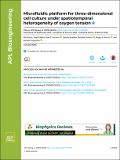| dc.contributor.author | Koens, Rei | |
| dc.contributor.author | Tabata, Yugo | |
| dc.contributor.author | Serrano, Jean Carlos | |
| dc.contributor.author | Aratake, Satoshi | |
| dc.contributor.author | Yoshino, Daisuke | |
| dc.contributor.author | Kamm, Roger Dale | |
| dc.contributor.author | Funamoto, Kenichi | |
| dc.date.accessioned | 2020-11-05T20:02:03Z | |
| dc.date.available | 2020-11-05T20:02:03Z | |
| dc.date.issued | 2020-03 | |
| dc.date.submitted | 2019-09 | |
| dc.identifier.issn | 2473-2877 | |
| dc.identifier.uri | https://hdl.handle.net/1721.1/128366 | |
| dc.description.abstract | Cells in a tumor microenvironment are exposed to spatial and temporal variations in oxygen tension due to hyperproliferation and immature vascularization. Such spatiotemporal oxygen heterogeneity affects the behavior of cancer cells, leading to cancer growth and metastasis, and thus, it is essential to clarify the cellular responses of cancer cells to oxygen tension. Herein, we describe a new double-layer microfluidic device allowing the control of oxygen tension and the behavior of cancer cells under spatiotemporal oxygen heterogeneity. Two parallel gas channels were located above the media and gel channels to enhance gas exchange, and a gas-impermeable polycarbonate film was embedded in the device to prevent the diffusion of atmospheric oxygen. Variations in oxygen tension in the device with the experimental parameters and design variables were investigated computationally and validated by using oxygen-sensitive nanoparticles. The present device can generate a uniform hypoxic condition at oxygen levels down to 0.3% O2, as well as a linear oxygen gradient from 3% O2 to 17% O2 across the gel channel within 15 min. Moreover, human breast cancer cells suspended in type I collagen gel were introduced in the gel channel to observe their response under controlled oxygen tension. Hypoxic exposure activated the proliferation and motility of the cells, which showed a local maximum increase at 5% O2. Under the oxygen gradient condition, the increase in the cell number was relatively high in the central mild hypoxia region. These findings demonstrate the utility of the present device to study cellular responses in an oxygen-controlled microenvironment. | en_US |
| dc.language.iso | en | |
| dc.publisher | AIP Publishing | en_US |
| dc.relation.isversionof | http://dx.doi.org/10.1063/1.5127069 | en_US |
| dc.rights | Creative Commons Attribution 4.0 International license | en_US |
| dc.rights.uri | https://creativecommons.org/licenses/by/4.0/ | en_US |
| dc.source | American Institute of Physics (AIP) | en_US |
| dc.title | Microfluidic platform for three-dimensional cell culture under spatiotemporal heterogeneity of oxygen tension | en_US |
| dc.type | Article | en_US |
| dc.identifier.citation | Koens, Rei et al. "Microfluidic platform for three-dimensional cell culture under spatiotemporal heterogeneity of oxygen tension." APL Bioengineering 4, 1 (March 2020): 016106. © 2020 Author(s) | en_US |
| dc.contributor.department | Massachusetts Institute of Technology. Department of Mechanical Engineering | en_US |
| dc.contributor.department | Massachusetts Institute of Technology. Department of Biological Engineering | en_US |
| dc.relation.journal | APL Bioengineering | en_US |
| dc.eprint.version | Final published version | en_US |
| dc.type.uri | http://purl.org/eprint/type/JournalArticle | en_US |
| eprint.status | http://purl.org/eprint/status/PeerReviewed | en_US |
| dc.date.updated | 2020-08-17T16:50:30Z | |
| dspace.date.submission | 2020-08-17T16:50:33Z | |
| mit.journal.volume | 4 | en_US |
| mit.journal.issue | 1 | en_US |
| mit.license | PUBLISHER_CC | |
| mit.metadata.status | Complete | |
